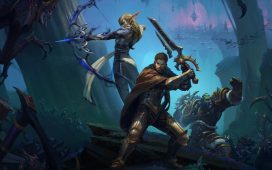The latest mini console is the most obscure yet, but Konami’s PC Engine Mini is a treasure trove of classic Japanese retro gaming.
After the Classic Mini NES and SNES, the disappointing PlayStation Classic, the excellent Mega Drive Mini, and the expensive Capcom Home Arcade it seems like the fad of mini retro console has come to a logical end.
As soon as you start to get into the 3D era of gaming the poor quality of the graphics and controllers suddenly makes them much less accessible than their 2D predecessors, and while we’d love to see a Classic Mini N64 or Saturn it’s hard to imagine it happening.
But there is one obvious route left and the mini console we’ve been looking forward to the most out of all of them, for the simple reason that we never had one originally: the PC Engine Mini.
The console is little known in the West; in fact speaking to Konami about it it’s debatable whether it was ever officially released in Europe at all, with just a few consoles trickling into the UK in 1990, before the whole attempt at a launch was quickly abandoned.
It fared a little better in the US but in Japan the PC Engine was bigger than the Mega Drive and while it was still stuck awkwardly between the 8-bit and 16-bit eras it was the most popular console in Japan for some time, before eventually being overtaken by the SNES.
That means it has a mountain of classic Japanese titles in its portfolio, ranging from near perfect arcade conversions to games and franchises that have never been released in the UK before – including a huge selection of 2D shooters (which just so happens to be our favourite retro genre).
The PC Engine was originally released by NEC in 1987 in Japan, but it and many of its games were made by Hudson Soft, who were bought up by and merged with Konami in 2012.
So we recently went along to Konami’s UK offices to try out the PC Engine Mini, which has three different forms depending on the region. The Japanese version is the original white one, the US one is called the TurboGrafx-16 (and gives the American SNES a run for its money as the ugliest console ever made), and in Europe it’s called the PC Engine CoreGrafx Mini, after one of the later hardware revisions.
Comparing the Mini to the original version it’s only a little smaller than it used to be, but as Senior Brand and Business Development Manager Richard Jones points out, ‘We’d already made a mini console in 1987. We kind of felt we had to reduce it a little bit, to fit the name, but you can’t do it by too much or otherwise there’s nothing there to hold in the palm of your hand.’
In basic terms the PC Engine Mini works just the same as other mini consoles, with a full-size controller and four save states for each game, to help cope with the high difficulty of many games of the era. Importantly, the emulation work is done by the peerless M2, whose involvement in any retro game is always a guarantee of quality.
M2 seem to have particularly relished their work with the PC Engine though, which can be transformed from Japanese to American incarnations at the press of a button and has not only a CRT filter, to emulate old school TVs, but also a number of screen ratio options, including the ability to make it look like you’re playing the games on the tiny screen of a portable PC Engine GT (aka TurboExpress).
It all seems to work very well, but it is of course the games which are most important feature and the PC Engine CoreGrafx Mini has 57 of them – an almost identical line-up to Japan. That’s a mixture of titles localised for America and those that were only ever released in Japan, which works out as 25 games in English and 32 in Japanese.
The full list is below, and as you can see a few of the games are doubled-up, but the only Japanese titles missing from the UK PC Engine Core Grafx Mini are dating sim Tokimeki Memorial and role-player Tengai Maikyo 2 (part of the Far East Of Eden franchise), which would be unplayable unless translated, and the Japanese version of Splatterhouse.
In return the Western versions of the console get the English language version of Splatterhouse and the Japanese edition of Salamander – which just so happens to be one of our favourite 2D shooters ever (and Bayonetta creator Hideki Kamiya’s, as we discovered when we met him once).
PC Engine CoreGrafx Mini final games list
English:
Air Zonk
Alien Crush
Blazing Lasers
Bomberman ’93
Bonk’s Revenge
Cadash
Chew-Man-Fu
Dungeon Explorer
J.J. & Jeff
Lords Of Thunder
Military Madness
Moto Roader
Neutopia
Neutopia 2
New Adventure Island
Ninja Spirit
Parasol Stars
Power Golf
Psychosis
R-Type
Soldier Blade
Space Harrier
Splatterhouse
Victory Run
Ys Book I & II
Japanese:
Akumajō Dracula X: Chi No Rondo (Castlevania: Rondo Of Blood)
Aldynes
Appare! Gateball
Bomberman ‘94
Bomberman Panic Bomber
Chō Aniki
Daimakaimura (Ghouls ‘N Ghosts)
Dragon Spirit
Dungeon Explorer
Fantasy Zone
Galaga ’88
Genpei Tōma Den (The Genji And The Heike Clans)
Ginga Fukei Densetsu Sapphire
Gradius
Gradius 2: GOFER No Yabō
Jaseiken Necromancer
Nectaris (Military Madness)
Neutopia
Neutopia 2
Ninja Ryūkenden (Ninja Gaiden)
PC-Genjin (Bonk’s Adventure)
Salamander
Seirei Senshi Spriggan
Snatcher
Spriggan Mark 2
Star Parodier (Fantasy Star Soldier)
Super Darius
Super Momotarō Dentetsu 2
Super Star Soldier
The Kung Fu (China Warrior)
Valkyrie No Densetsu (The Legend Of Valkyrie)
Ys I & II
Since most of the games are action titles the Japanese text is not an issue for most of them, although there is one special case: Hideo Kojima’s Snatcher. Predictably, Konami hasn’t used the translation from the Mega CD version, although Jones indicated that they were also worried that, ‘the intended humour in the game would get lost in translation and spoil the experience for both existing and new fans.’
It’s a shame, but translating such a text heavy game would be difficult, as the game is essentially a visual novel, but just watching it play out with its state-of-the-art 1992 2D visuals is a fascinating experience, especially given how brazenly the game rips off visuals from the likes of Blade Runner and The Terminator.
One of the core arguments surrounding the PC Engine has always been whether it counts as an 8-bit or 16-bit console, since its innards are a mixture of the two, but many of the games on the Mini are very impressive from a graphical standpoint and hold up just as well, or better, than contemporary SNES games.
We had a few minutes on a range of different titles, including the near arcade perfect R-Type and Ghouls ‘N Ghosts to the glorious, and long forgotten, Rainbow Islands sequel Parasol Stars and five-player Bomberman ‘94.
Then there was Castlevania: Rondo Of Blood, a key title in the evolution of the franchise; Ninja Gaiden; a number of platform titles featuring mascot Bonk (aka PC-Kid); racing games such as Victory Run; role-players such as Ys Book I & II; and pinball game Alien Crush.
Another that took our fancy, that we’d never heard of before, is Appare! Gateball, which turned out to be a sports sim based on a Japanese variation of croquet and which we had an enjoyable time playing in two-player mode with another journo, as we both struggled to work out the rules.
Although the absence of Capcom’s Street Fighter 2 was unsurprising, the only other notable omissions we noticed were Alien Crush sequel Devil’s Crush and Lords Of Thunder predecessor Gate Of Thunder. We asked Jones why this was and he answered that it was an attempt to balance the genres on the console, adding: ‘If we have an opportunity to add them in the future, we will reconsider it.’
Whether that means the console will be able to download DLC we’re not sure, but to be fair the PC Engine is already an Aladdin’s cave of classic 2D shooters, from beloved classics such as Star Soldier and Gradius to ones we’ve never played before, such as Spriggan Mark 2 and Ginga Fukei Densetsu Sapphire.
The latter was originally released on the Arcade CD-ROM² format and features some of the best 2D sprite work we’ve seen from the era, including more ripping off of Blade Runner and enemies that look like polygonal models out of Star Fox but are actually just very smoothly animated sprites. But then the game should look good as it was released in 1995, almost a year after the original PlayStation came out in Japan – a tribute to the extraordinarily long life of the PC Engine in its homeland.
The PC Engine CoreGrafx Mini is exclusive to Amazon.co.uk, where it costs £99.99. Not an inconsiderable sum but you could easily pay more than that for just one of the games in their original form. It will be released on 19 March, with extra controllers and a multitap – that allows you to use five controllers at a time – available separately.
For retro gamers it seems like a must-have but the inevitable question that came to our mind is what, if anything, does this mean for Konami’s future engagement in the games industry? After almost seeming to give up on traditional console titles, will any of these franchises, or the Hudson name, return? And what about more modern games like Silent Hill and Castlevania, many of which Jones has worked on in the past?
‘We have not changed our stance on providing games all over the world for many people to enjoy’, is Jones’ predictably corporate response.
‘We’re excited for our fans to play and enjoy the PC Engine Core Grafx Mini. We will continue to listen to their feedback and consider adding extra titles to the console in the future’, he added – again implying that it can receive DLC updates.
It’s impossible to guess what, if anything, the PC Engine Mini might mean for the future of Konami, and Hudson, but at the very least it seems like the perfect celebration of a console that, particularly in Europe, was in danger of being forgotten.
Email gamecentral@ukmetro.co.uk, leave a comment below, and follow us on Twitter
MORE: The C64 Maxi Micro Computer review – Commodore reborn, again
MORE: Capcom Home Arcade review – the biggest mini console ever made
MORE: Sega Mega Drive Mini console delayed in the UK



















